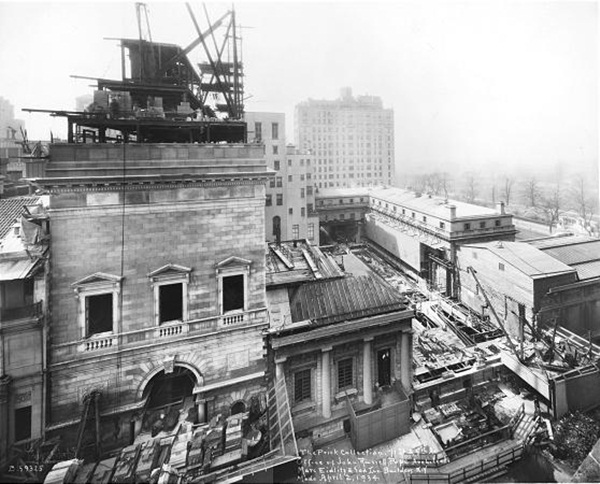
The Construction of the Frick, via The Providence Journal
The Frick Collection is celebrating its seventy-fifth anniversary this year, after opening its doors in 1935. To commemorate this occasion the Collection is showing a few elevation sketches of the building’s transformation from the home of industrialist Henry Clay Frick into the museum we see today. The only other addition is a new orientation film, which “tells the story of Mr. Frick, his home, and his art collection.” Here we learn of the remarkable journey of this “man of the highest quality” who from humble origins and a sickly childhood pulled himself up by his bootstraps to become a millionaire at 30, and one of the great industrialists of the gilded age. We hear of his success as a coke magnate (the raw material used to make steel), his partnership with Joseph Carnegie, his leadership of U.S. Steel and his building of this grand and historic 5th avenue mansion. We hear how his love of art led him on a “chase for the old masters”, and of how he “went shopping” at the Metropolitan for the highlights of J.P. Morgan’s collection after Morgan died. We hear how it “wasn’t enough to have a great collection of old master paintings so he began to buy great pieces of furniture and decorative art.” We learn how the press avidly covered his art collecting and purchases with as much panache as they covered his feats of industry. We learn that he stipulated the creation of this museum upon his wife’s death so “the entire public should forever have access.” We learn that much of the museum is how Frick left it, when he lived there, and, in addition to viewing his art we “can also inhale the Gilded Age, the sense of the aesthetic, the beautiful” contained in these rooms.
What we don’t hear of is how Frick was once “the most hated man in America.” We don’t hear how Frick stood out among the many ignoble plutocrats of his day for his violent assaults on organized labor. We don’t hear the story of the 1892 Homestead Strike where Frick, despite soaring profits in the steel industry, offered the skilled workers of the Amalgamated Association of Steel and Iron Workers a 22% wage decrease, then summarily locked them out of his factory by building high walls replete with guard towers, barbed wire, and high pressure cannons capable of shooting scalding liquid at every entrance. We don’t hear how when the workers struck and shut down the factory, Frick hired the notorious Pinkerton Detective agency to invade Homestead by river, shooting into the strikers and the supporting townspeople in order to clear the way for scab labor. We don’t hear of how the National Guard was summoned to break up the strike and eventually the union, which Frick steadfastly refused to negotiate with throughout.
We don’t hear that Portfolio.com named Frick one of the “worst CEOs of all time.” We don’t hear how his construction of a dam to create a private lake for a fishing and hunting club, failed, due to poor maintenance and heavy rainfall, and caused the Johnstown flood of 1889 which killed over 2000 people and coincidentally knocked out his competitor’s factory (Cambria Iron and Steel) for a year and a half. Or of the legal battles Frick and his compatriots fought to insure they would not be held responsible and the conspiracy they hatched to keep the club’s existence a secret.
We don’t hear of how Frick’s relentless use of violence fractured his relationship with his partner Joseph Carnegie, a notorious robber baron in his own right. We don’t hear how his subsequent feud with Carnegie pushed him to build his mansion on fifth avenue “to make Carnegie’s place look like a miner’s shack.” Or of how he moved his art collection to New York because he was worried that the soot from his own steel mills in Pittsburgh would damage his paintings.
The orientation film provides nothing beyond a clear vision of the way the Frick Collection wants to be seen. It’s ostensible subject, the works of art that Frick collected to share with the public, are given scant attention. There is no historical background on the work. We hear nothing about where these pieces are situated in the oeuvres of their respective creators, their influences or artistic heirs. We hear no insight on the importance of the work at all; or even why Frick chose them. If we want to know more about a piece than it’s title we must purchase a guidebook as an added cost to the already hefty admission fee. In truth, the only thing the film orients us to is the life of Frick himself. This is a thinly veiled attempt to cast the institution as a historical museum, as one of the few mansions restored to show what life was like in the Gilded age. Yet there is no information on everyday life at the turn of the century, no details on the workings of a house that once employed 27 servants. This is not The Tenement Museum, where every object reveals a story about the lives, activities and dreams of the people who once lived there. Had this information been available, I might have learned of the styles and daily habits of life in the early 20th century. Instead, the objects are left to float in their opulence, with no connection to the lives they furnished or acknowledgment of the vast discrepancy in income between their owners and those whose labor paid for them. What is underlined is that this museum is how Frick left it, how he lived in it. The paintings and decorative objects are largely of his choosing. The work is arranged not by school, chronology or any other typical conceit, but by his whim. They are treated as aesthetic niceties without context or consequence. I learned nothing of the historical period, of how life was lived, or anything historical at all, really.
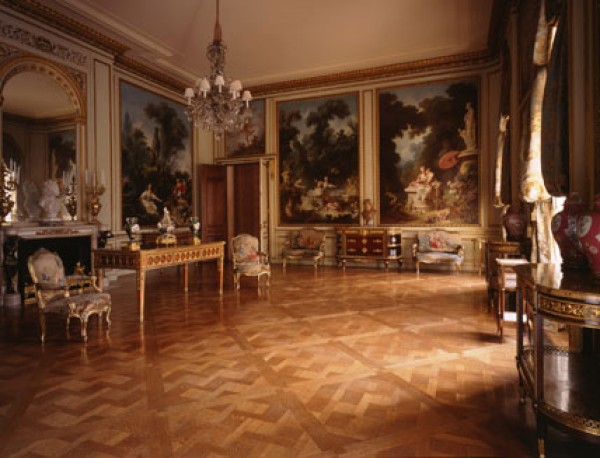
Inside the Frick, via Great Art Collections
What is being presented at the Frick Collection is a revisionist biography of Henry Clay Frick. It is where we go to learn how the great man, this American noble, lived and gathered these objects. We are asked to bask in his reflected glory, in awe of the refinement of a “man of the highest taste.” In truth, Frick bought for chiefly for names; having had the money to do it. So yes, there are impressive Rembrandts, a gorgeous El Greco, and a Vermeer. But none of these works have matured into the significant masterpieces one would expect from a “man of the highest taste.”
He bought pictures he found pretty and of images of powerful men; men he would like to be compared with or with whom he might like to be friends. The art was an avenue to fame, and a way to cement his status. Tired of being second to Carnegie, embarrassed by his humble origins, we see a man desperate to prove his aristocratic legitimacy, displaying that all-too-American desire for the old European pedigrees of class, power and title. For all his wealth and influence, the American plutocrat has no noble lineage, no royal lines traceable back through the centuries, his remains the clichéd ostentation of new money; the flaunting of power and opulence in a desperate grab for legitimacy and sophistication. Acquiring the Old Masters is a well-worn method of manufacturing the culture sanction that is the legacy of old Europe. It is difficult to imagine a more perfect testament to this process than The Collection; from the portraits of Thomas More and Cromwell, to Bronzino’s portrait of the renaissance noble Lodovico Capponi, down to the collection of English poets (Tennyson, Shakespeare, Shelley…) displayed in complete and untouched collections filling the bookshelves of an entire room. None of this, in and of itself, is surprising
What is surprising is that, 75 years after its opening, and a mere two years after the heirs to Frick’s unrestrained greed nearly demolished the economy, the museum that bears his name is still possessed by his insecurity. Ensconced safely in the most expensive real estate in the richest city in the most powerful empire in history, the Frick Collection, by way of an insipid video tribute, still presents the same pitiable adolescent churlishness and hapless desire for approval evinced by the man himself. Decades later, Frick’s wealth remains as opulent as ever, but it has yet to afford him or his legacy the comfort and belonging common to the poorest worker awaiting his bullets in Homestead.
The tragedy of The Collection’s design, with its emphasis on Frick and his taste, is the obfuscation of the art itself. What separates art from ordinary objects is that it lives in the interaction between the work and the spectator. It persists long after its creator, continuing to speak to us, to interact. The art work is unique, and gains this uniqueness, as Benjamin points out, by virtue of the “here and now of the work of art.” But this uniqueness “bears the mark of the history to which the work has been subject.” In short, the work is conditioned by its location, its context, its historicity. The insidiousness of the Frick is that Henry Clay inserts himself into the relationship between art and spectator. The gilded rooms frame the art in a veneration of capital and privilege. Our relationship to the art is qualified by the ongoing glorification of its former owner. We see the figures in these paintings as men like Frick. We see beauty as the property of wealth. The artwork is denigrated to an object whose value is limited to representing the triumph of exchange. The public does not get the full benefit of the art after all.
The ever-diminishing line between art and commodity is not a new problem; it pervades the history of western art since the renaissance. One thinks of the Medicis’ use of frescoes and other commissions for political gain. However, unlike the Medicis, Frick did not support the most adventurous artists of his day. He was not a patron of new and radical work. He simply bought what was already considered masterful, by artists long dead. All of our great institutions of art walk this line. The Metropolitan and the MoMA were founded and are funded by businessmen not unlike Frick, but at least they had the decency to build a legitimate museum in the public trust, and not a temple to themselves.
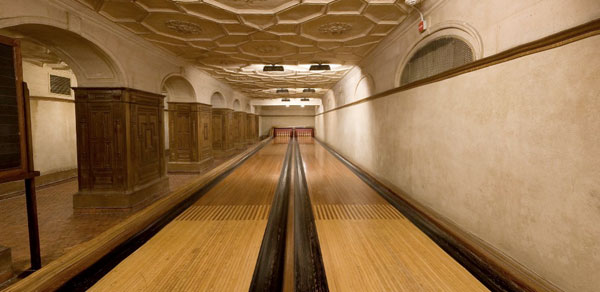
The World's First Private Bowling Alley, via doobybrain
Indeed, The Frick Collection is less a museum of art than a mausoleum to the man. Instead of a ruthless industrialist who littered his road to riches with plebeian carcasses, Frick is reborn as an art lover and a philanthropist. By gathering the trappings of class and nobility, surrounding himself with beauty and art, he hastened to help us forget his crimes. We are supposed to be in awe of his taste, his exceptionalism, and to be humbly thankful to the great man for bestowing his culture and class to the unwashed rabble that is the public. The New York Times writes that The Frick Collection is “an oasis, a haven and a lighthouse… as noon draws near we catch ourselves wondering whether we shall be invited upstairs for a glass of dry sherry and a biscuit.” But the truth is that Frick would never have allowed us into his home, much less deigned to share a drink. We will never be allowed upstairs; a velvet rope prevents us, just as it prevents us from sitting in his chairs. It is literally over his dead body that we are allowed inside at all.
The Frick represents the legacy of America’s favorite fantasy: that the cupidity of the few somehow happens separately from the misery of the many, making this lifestyle available to all. That we are still told to revere these “great” men is all the more galling having just watched a new generation of Fricks make their fortunes without even creating useful infrastructure or industry in the process. The names, companies, and industries may have changed, but the game remains the same. Even with all of the anger at Wall Street, Main Street still comes to the Frick, smiling, full of awe, and wishing that someday, they too could live like this. Maybe in another 75 years, we can all tour the homes and art collections of Lloyd Blankfein and Tony Hayward to better appreciate their dedication to the common good. Ideological in the most specific sense of the word, institutions like the Frick naturalize the divine right of wealth and the means used to obtain it. They allow us to tour the beauty of the home, to gaze on the riches amassed and continue in the pacifying delusion that the wealthy and connected are the caretakers of America, the essence of freedom, instead of those keeping the poor in poverty and the starving hungry. No effort at orientation can make this Collection, the crimes that created it, or the veneration of greed it embodies, make sense.
]]>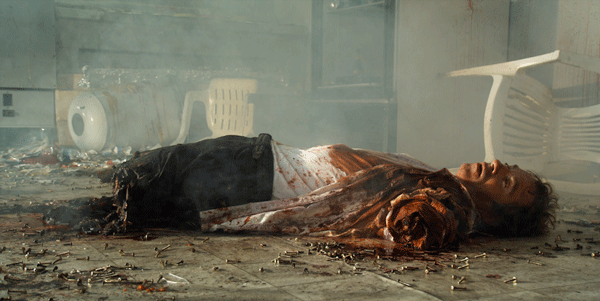
Omer Fast, Take a Deep Breath, 2008 via Postmasters
I don’t deal directly with reality but with representations and stories. The truth basis of what I am doing is not interesting to me. In the act of storytelling, there is a truth.
-Omer Fast in New York Magazine Dec. 21-28 2009, quoted in Postmasters’ press release
Omer Fast’s show at Postmasters Gallery (through February 13th) consists of two videos. Both are set in entirely black rooms, with carpeted floors, a spare modernist bench and minimal light excepting that emanating from the images on screen.
The first room consists of Fast’s 2008 piece Take a Deep Breath. Two screens hang, slightly staggered, in the middle of the room, on which we see the same scene depicted from two different points of view: it’s a film crew recreating a suicide bombing in Israel. They interview an Israeli man who, upon entering his favorite falafel shop, stumbles onto the scene and performs CPR on a man whose arms and legs have been severed in the blast, only to realize afterward that the man was, in fact, the suicide bomber. The body of the film deals with the personalities, logistics and production of the reenactment, exposing a level of artifice that extends backstage, where we see similarly self-conscious performances.
This question of self-consciousness continues in the second piece, De Grote Boodschape. This film follows six characters in an apartment building in Mechelin, Belgium. Their perceptions of events, and their account of what is taking place, differ on every level, reflecting the melting pot that is contemporary Belgium. Multiple identities are created and subverted by overlapping cultural legacies: we witness a white youth embrace hip-hop and long for the death of old Europe, while fear of Arab terrorists preoccupy the middle class. The piece is well made, almost tidy, even, in the interlacing of its contradictory details. We see the international specter of terrorism underlined by the profession of the neighbor’s wife – she’s a flight attendant. The pills the grandmother stockpiles recall the pills her father stuffed with diamonds and swallowed to keep them from the Nazi’s. The grandmother’s pills may or may not contain her jewels. The girlfriend is either stealing the grandmother’s pills or protecting her from addiction.
For a while I struggled to clarify the details of the conflicting stories, but then, that is precisely the point. Irreconcilable with any “actual” accounting of events, the story exists only as a collection of stories, each conditioned by the context and viewpoint of the individual encountering them. We cannot assimilate all viewpoints at once. Details of events contradict as styles of storytelling slam into one another. When the actor playing the terrorist pulls off his fake nose, while simultaneously revealing he is Kosovar, the experience is wholly disconcerting. The same gesture that reveals the actor as a “fake” Arab also identifies him with an experience of sectarian violence. There is thus the immediate validation of his “authenticity,” while, at the same time, an uncomfortable gesturing towards the conflation of all sectarian conflicts within in the dominant discourse. Reinforcing this effect is the actor’s sudden replacement with a middle-aged white man. How can such an actor play a terrorist? He can’t be “right” for the role? Yet, when we finally see the aftermath of the bombing, we cannot tell which actor is playing what amidst the destruction, until the director yells “cut”. Our assumptions regarding terrorist identity are troubled while any and all individuality is lost amidst the violence.
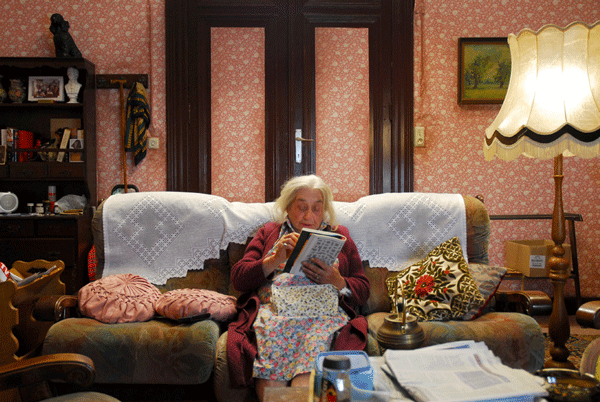
Omer Fast, De Grote Boodschap, 2008 via Postmasters
There is a similarly wonderful moment from Der Grote Boodschape where we see a DJ lip-synching to beat boxing being performed by a character on his computer. Here too, the confrontations with our expectations are startling. First we see a white man beat boxing along to a recording and assume his relation to the music is other than that of its creator, to say the least. When it is revealed that he is singing along to himself, he shifts from consumer to cultural producer, legitimating his standing. The image of him beat boxing authenticates his talent, validating his activity as more than a hobby, and revealing him as a professional. Here, the image becomes more real than the actuality of practice.
Fast is fascinated by this relationship between representation and truth, the truth and the lie of the image. The image speaks, it tells a story and thus contains a truth, but it is also, necessarily, “not real.” Take a Deep Breath manages to stretch the question of the “real” out for almost the duration of the film. By exposing a certain spectacular mechanics, the film throws certain congruences and parallels into sharp relief. Particularly jarring is the abutment of the narration of the would-be savior with the scenes backstage. It quickly becomes obvious that the “backstage” conversations are as fictional as the re-creation of the terrorist event. And this revelation is delightful, and the discussion of whether the terrorist/victim is a real amputee or is faking it, particularly so. What emerges is the duality of the representation itself. The image as representation is incommensurate with the object or event it signifies. Thus it is impossible for us to ever see the reenactment of the terrorist bombing and its aftermath. We see fragments, interrupted by acting failures or creative argument. We see the aftermath and the apparatus, but the event itself remains absent, un-representable. This does not mean that the representation does not communicate, to the contrary, in many ways the image becomes more “real” than lived experience; as spectacular society endows the essentially false with the absolute authority of truth. “In a world that is really upside down…”
It is this aporia between the falseness of representation and the truth it communicates that Fast mines so successfully. Reality has no place in his work. It becomes impossibility. Recognizing that fidelity to the event, through the lens of representation, is absurd, Fast fully embraces that absurdity. We see the actor climbing out of the apparatus that hides his intact body, leaving gory stubs of the victim’s limbs lying abandoned on the set, and leaving us, in turn, with a perfect portrait of the mechanics of storytelling. Here, Fast articulates the unique responsibility of art in spectacular society. Art, being a moment of the false, thus carries with it the authority of the true. Yet, it also declares itself as false. Unlike the image-commodity, art is necessarily not the “real.” If it were, it would not be art; it would be an everyday object. By virtue of its “artness” it must be a representation, not an actuality. This allows art the opportunity to critique the image and delineate the gap between representation and actuality. Art creates situations that expose the gears of the spectacular machine. The representation becomes self-conscious and allows us, as spectators, to recognize both the truth and failure of the representations that dominate our lives. By concerning himself with “the act of storytelling,” Fast creates this clearing for the viewer. This is likely why so much of the criticism of Fast’s work hinges on its relation to the media. This is a mistake. Fast is not concerned with the media per se, but with the mediation of our lives through the lens of spectacle.
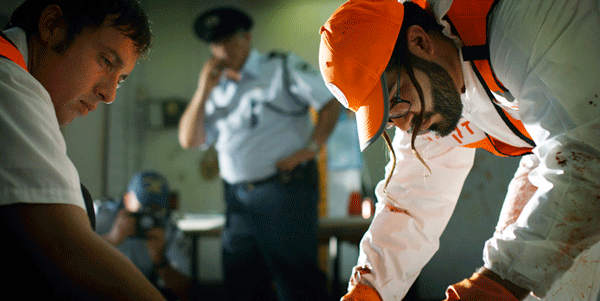
Omer Fast, Take a Deep Breath, 2008 via Postmasters
The relationship at work between art and terrorism in Take a Deep Breath dramatizes this point. Charting the relationship between the act of making art and terrorism, Fast reciprocates between the two, recalling not only the threat (ostensibly) posed by the artist to the established order, but also the spectacular nature of terrorism. Fast makes these points subtly, by implication only, and there is some fertile territory left un-mined. What, for example, is the unique role of representation in art and in terrorism? All terrorism, by definition, is a spectacular event meant to signify something beyond its physical repercussions. The World Trade Center, clearly, was targeted for its symbolic value as much as because it was a large building with a great number of people inside. Terrorist attacks are intended to haunt a whole society, literally to terrorize via the creation of an image that persists long after any immediate, physical repercussions. In this sense we can see just how successful the “terrorists” have been. They have succeeded in creating a specter of a forceful, coherent opposition to “Western democracy” far greater than any extant power. Contemporary terrorism thus understands the spectacular society and exploits it. Like art, it targets symbols and creates situations that destabilize and undermine the dominant spectacular power through its own language. We can see this in the silence of the Arab in Der Grote Boodshape, in which we are left to project our feelings about “Arabness” onto him – is he a threat or a decent man? It is left to our perception.
However, unlike art, the experience of terror re-inscribes the illusion of the image. It forces us to buckle down, to reinvest in the spectacle and offers appearances justifying repression and war. Art provides an occasion to debase this re-inscription. The position of art in relationship to this cycle allows us to expose the spectacular nature of both terror and our response. Fast flirts with these connections, but too often gets distracted with the mechanics of the representational apparatus, work that is done for him already by the nature of the artwork.
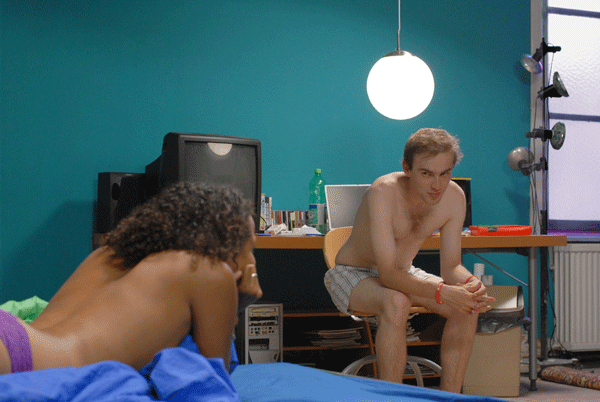
Omer Fast, De Grote Boodschap, 2007 via Postmasters
Indeed, the extended emphasis on detailing the multiple uncertainties at work in the representation was, at times, a little heavy handed. I did not need so many discussions of what would make the art more “real” or the repeated references to the actors breaking with reality. The loud insistence of the “director” that he is not making pastiche was also a bit much. If one cannot recognize the postmodern fracturing at work here, one is not paying attention. Similarly, the police officers bordered on parody, undermining the tension in the artwork’s delicate dance with reality. Too often the work exerts itself to expose its construction at the expense of visceral connection.
That said, Fast, the character, is correct insofar as neither of these films are pastiche, and Jameson is put to good use here. With his self-referential debate on the role of the artist, Fast undermines his own pretension and the egoism implicit in artistic creation. However, this is work already accomplished by the nature of the videos themselves, and Fast is too meticulous, too good, really, to necessitate such obviously self-referential remarks. While this might be merely wearying, it actually runs a far greater risk, given the circumstances. By mocking the narrative techniques that build the film’s meaning brick by brick, Fast risks repeating the documentarian objectivity he is so fastidiously trying to avoid. When Fast treats the police officers in Take a Deep Breath with such farcical levity, they cease to signify anything. The wonderful friction that is provoked when they ask, “Are you guys making film about terrorism?’” is lost to their buffoonery. The fear contained in their question, “Is it a political film?” encourages us to laugh at their stupidity, and we miss something of the significance of their question. Lyotard defined postmodernity as the “incredulity towards meta-narratives,” but that is not the same thing as a complete absence of meaning. Lyotard encourages us to find the multiple “little narratives” that exist in every story and take them together to create a picture of the event. The “language game” is not just a game with language. Language does communicate, though partially. Real meaning exists; just in fractured, contradictory and incomplete bits. If the hallmark of modernism is the governing of thought by any objective principle, narrative nihilism is a modernism as well. By undermining the undermining of the artifice of representation, by stepping outside to comment on that project, Fast risks re-inscribing the very paradigm that he is laboring to avoid.
To a lesser extent this criticism extends to the formal presentation of Der Grote Boodschape. The two screens, in Take a Deep Breath, are literally multiple eyes, seamlessly highlighting the multiple “I”s that tell the same story in different ways. However, the larger screen, set movie house style, in Der Grote Boodschape presents us with a traditional cinematic eye. Though the story was multiple, the presentation was objective; a singular “I” governed what we could see. Additionally, the camera technique of sliding through the walls of the apartment building felt suspect. It obscured the fact that these conversations were not contemporaneous, connoting an Aristotelian unity of time that did not exist. What privileged us, as spectators, was the ability to simultaneously see fragments of conversation that were not simultaneous and juxtapose them. When the camera slid through the wall to the next scene this insight was debased, and the “I” of the camera accomplished the work for us.
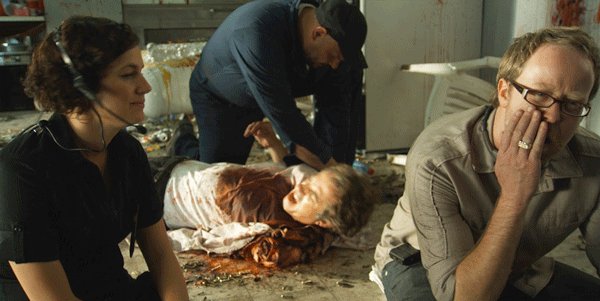
Omer Fast, Take a Deep Breath, 2008 via Postmasters
However, it is this precisely the rigor of and the focus on the act and apparatus of storytelling that makes Fast’s work so successful. Brecht famously said, “Art is not a mirror to reflect reality, but a hammer with which to shape it.” Here we can see two of the dominant schema of modern aesthetics; the Romantic and the Didactic. In the Romantic paradigm, art is a truth procedure unto itself, revealing a truth that cannot be expressed in any other way. Perhaps the paragon of this schema would be the Kantian sublime: the encounter with the infinite that exceeds our mortal capacity, and which we thus call beautiful. Art is here the mirror that allows us to digest the grandeur of nature. This is contrasted with the Didactic schema, espoused by Brecht, and, in an entirely different way, by Plato. In this view, art contains no truth. Truth is external to art. In Brecht’s case, this was the truth of dialectical materialism. Art’s function is then to educate society, to guide us toward recognition of the pre-existing truth; in Badiou’s wonderful phrase: “Art, under surveillance, is a therapy against cowardice. Not cowardice in general, but against cowardice in the face of truth.”
Fast is not interested in art as either mirror or hammer. He does not seem to believe that there exists a singular “reality” for art to mirror, nevermind shape. Instead, he clears a space for art separate from politics. If politics is the work of forming and defining societal rules and laws, art elucidates the individual difference that is obscured by the abstract generalities therin. Fast’s aim is to provoke and inform the political discussion, engendering of a more considered, informed and challenged polis that can then engage in political discussion. Fast’s view echoes the Romantic paradigm in some senses, but not in the Kantian mode, rather a more Heidggerian version. Here art remains a truth procedure; it is still not subordinated to another modality of thought. The question instead becomes about the specific nature of the truth proper to art. Badiou argues that this truth is not proper to art itself, but that “the infinity of truth is the property whereby it subtracts itself from its pure and simple identity with the established forms of knowledge.” Badiou then claims that this vision of truth functions to reproduce the artist as a Christ figure; a divine revelator of the absolute truth. However, Fast, by way of Heidegger, troubles this analysis. He presents us with no absolute truth to be revealed. His truths are partial and multiple. Like Heidegger, he wants to remove the conception of truth from correctness. Truth is a revealing, a clearing, where we can see the setting up of two opponents in “strife”. Truth is an opening where we can view confrontation more clearly, to quote Heidegger, “in strife each opponent carries the other beyond itself.” This is precisely the work Fast’s films engage in. The telling of the multiple stories forces the spectator to hear multiple viewpoints and leaves us with questions rather than answers. We are allowed to see the background that founds each character’s view, and to find moments of empathy with each. When we hear the medic in Take a Deep Breath describe his frenetic hand-washing after learning the trued identity of the man he tried to save, we both sympathize with the horror of trying to “remove the smell of blood in [his] mouth,” and recognize the implicit racism at work in his fear and guilt in trying to help a terrorist. Then we learn that the bomber had hepatitis. Truth lies not in revelation, but in conflict, in setting differing views, facts, and things against each other. Thus the work of art cannot be reduced to the site of divine revelation. There is no singularity to reveal.
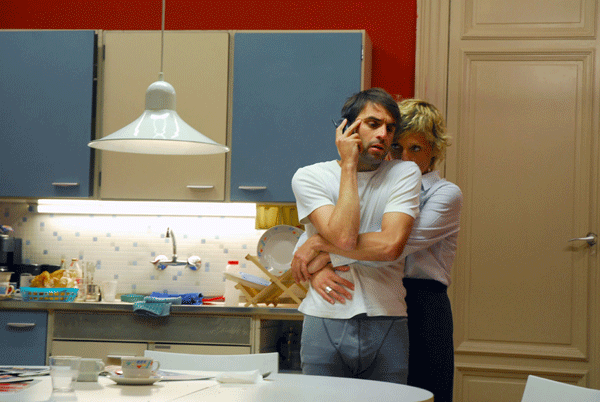
Omer Fast, De Grote Boodschap, 2007 via Postmasters
Fast’s commitment to a fundamentally Heideggarian aesthetic understanding can be seen in his absolute refusal of didacticism; all the more remarkable for the manifestly political content of his work. Fast’s work is the beginning, not the end, of the conversation. We, as audience, listen, and, bringing our own individual subjectivities to bear on what we hear, are left to sift through these stories for meaning.
The most profound moment of the show occurred as I was leaving. I walked from the second room back through the first, and encountered the film playing to an empty space. Here was a story working so hard to be told, but there was no one there to listen. The spectator, necessary for the work of art to engage in a truth procedure, was missing. As Heidegger says, “The unconcealment of being- this is never a merely existent state, but a happening.” The audience is needed for the clearing to emerge. It is our engagement and investment with the work of art, with the story being told, that allows truth to emerge. We must converse with the work, and each other, to discover any meaning; in this way the work of art, Fast’s in particular, forges a politics to come.
]]>